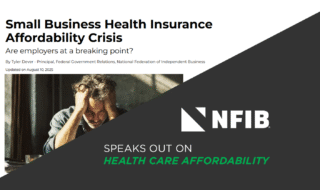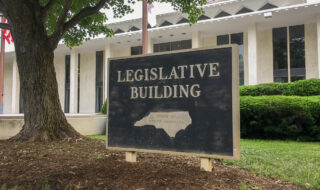September 5, 2025
How policymakers can create more affordable options
New Hampshire ranks among the healthiest states in the country – number one overall, in fact, according to a recent report from America’s Health Rankings. This includes top billing for the health of women and children among all states.
At the same time, small businesses rank health insurance affordability as their number one problem – and have for nearly 40 years, according to NFIB’s Small Business Problems & Priorities.
In the first post, we looked at the state of the two health insurance markets that primarily serve small businesses and their employees.
In this post, we discuss four options that policymakers can pursue in response to current and looming problems in these markets.
Small Employer ICHRA Incentives. One option gaining traction in several states is establishing incentives for employers to offer Individual Coverage Health Reimbursement Arrangements (ICHRAs).
An ICHRA is a newer type of employer-funded healthcare account that carries significant tax and practicality advantages for both employer and employee. For employers, it is considered a business expense, and contributions are deductible at the federal level.
For both employers and employees, employer contributions are not considered wages and are not treated as taxable income or subject to SSI and Medicare taxes.
Importantly, an ICHRA can be used by the employee to pay for health insurance premiums and qualified medical expenses, rather than just qualified medical expenses like Health Savings Account (HSA).
Unlike an HSA, employees cannot contribute to an ICHRA but an ICHRA can be paired with an HSA to maximize tax-advantaged healthcare savings for an employee. And the employee can keep their health plan when they switch jobs.
As discussed in Part I, small businesses in New Hampshire and across the country are struggling to offer health coverage to their employees.
In response to the declining ability to offer a benefit that is vital to employee recruitment and retention, many states are considering targeted HRA incentives to help small employers compete with big business.
In Indiana, lawmakers established a tax credit for employers with fewer than 50 employees who contribute to an ICHRA:
– up to $400 per employee in year one; and
– up to $200 per employee in year two.
The credit is equal to the amount the employer contributes, up to the limits above, so long as the amount contributed is equal to or greater than the amount the employer paid toward premiums in the previous year (including if the employer didn’t offer insurance coverage and the amount contributed was $0.).
The credit can be taken against several business taxes but cannot exceed the employer’s tax liability. However, unused credits can be carried forward for up to ten years after the year in which it was claimed.
Indiana cuts off eligibility for the credit when annual claims exceed $10 million – those who filed a claim prior to the cutoff receive it, those who come after do not. If scaled based on population, a comparable cap would be much lower in New Hampshire.
Another advantage to HRA tax credits is that it encourages more people to enroll in the Individual Market where average premiums are significantly lower than the small group market.
Association Health Plans Let Small Businesses Save Money Together. Association Health Plans (AHPs) and Multiple Employer Welfare Arrangements (MEWAs) have been a holy grail for small businesses for decades. Layers of complex regulations at the federal and state levels have made that difficult despite bipartisan efforts to improve access.
The current state of AHPs/MEWAs in New Hampshire is captured in a 2018 NHID memo, which states:
The New Hampshire legislature has previously attempted to provide similar flexibility for small businesses under state law; however, these efforts as they currently stand are not compatible with federal law, even under the AHP rule.
In 2019, efforts to reform the AHP restrictions fizzled in a partisan dispute and faded entirely after federal courts invalidated key portions of a 2018 federal rule change that made it easier to form AHPs.
Given the complexity of establishing a MEWA under federal law and rules, some states have tried to make it easier for multiple small employers to band together in a joint self-insured plan.
In 2017, Minnesota passed a bipartisan Agricultural Health Cooperative law, which created an industry-specific alternative pathway to establish a joint self-insurance plan that is largely federally regulated and subject to limited state regulation.
This law spawned at least two new coverage options for farmers and other agricultural employers at a time when higher premiums and narrower provider networks were causing people to drop their coverage.
Because it predates the now-invalid 2018 federal rule, Minnesota’s law offers a guide for MEWA reform that is permissible under current federal restrictions. It can be broadened to apply to any industry, and the type of governing entity can be modified to be any nonprofit instead of a cooperative (which was uniquely applicable to the agricultural focus of the law).
More Affordable Options for Catastrophic Coverage.
Short-term limited duration (STLD) coverage offers an affordable option for younger people, those between employment, and others who cannot afford the price of an individual market plan. STLD plans are generally regarded as catastrophic coverage, are not comprehensive, and are not subject to expensive federal regulations.
In the last decade, federal regulations on STLD plans have seesawed with presidential elections:
2018: the Trump Administration changed federal regulations on STLD plans to allow them to be sold for an initial term of 364 days or less and renewed for up to 36 months. At the time of the 2018 rule, the average STLD plan was less than one third the cost of an ACA-compliant plan.
2024: the Biden Administration reversed the earlier rule and capped STLD plans at three months with the option to renew for only one additional month. The Biden Rule mirrors Obama-era restrictions on STLD plans enacted to bring more people into the Individual Market.
2025: Last month, US DOL, HHS and Treasury published notice that they do not intend to enforce the Biden-era restrictions and encouraged states to follow suit.
New Hampshire law limits short-term plans to six months and not more than 540 days in a 24-month period. RSA 415:5, III. The former limitation was common among states before the ACA and the latter restriction was added in 2009.
New Hampshire’s STLD law could be easily modified to allow Granite Staters to take advantage of this option for the full length allowed under federal regulation.
Critics argue that STLD are “bare bones” plans that trap people with surprise bills. However, they represent the only affordable option for many people and – if they are properly marketed and limits are transparently advertised – offer a life raft from having to pay the full cost of major medical expenses out of pocket.
As discussed in Part I, it is likely that thousands of folks will be looking for more affordable options when enhanced federal premium tax credits expire at the end of 2025.
Level Playing Field for Expensive Specialty Drugs.
As detailed in Part I, higher spending on specialty drugs is a major driver of higher health insurance premiums.
The underlying causes are many and state policy solutions are often elusive. However, policymakers can achieve significant savings for patients and plan sponsors by leveling the playing field between public programs like Medicare and commercial insurance on the cost of hospital administered specialty drugs.
In Vermont, lawmakers took drastic action in response to a report published by RAND Health Care in December 2024 and other data showing massive hospital markups on specialty drugs that drive up insurance premiums. RAND found that Vermont hospitals had the highest markup in the nation at 500% of Average Sales Price (ASP).
Calling it “price gouging,” lawmakers there leveled the playing field between public programs and commercial plans by bringing the markup for hospital-administered drugs much closer to the Medicare reimbursement level (120% of ASP for commercial compared to 106% of ASP for Medicare Part B). See 2025 Act 68. This law will save patients and policyholders at that state’s largest insurer $46 million per year and reduced requested premium increases by 4% for 2026.
Even with a lower average markup (~300% of ASP), New Hampshire patients and commercial policyholders could see meaningful savings from similar action.
NFIB is a member-driven organization advocating on behalf of small and independent businesses nationwide.
Related Articles














